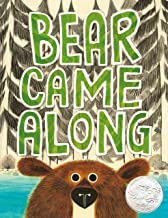Comprehension Strategies: Monitoring for Meaning
September 05, 2022One of my favorite activities in the library during the school year is storytime, and the stories we've already shared in these early days of the school year have already been enormously fun!
Storytime is about more than just fun, however, and it is a delight to explore all kinds of literacy and learning concepts through stories as well as to watch students grow in their comprehension throughout the year. This past week, in fact, Kindergarten storytime served to highlight one of the ways we develop comprehension through sharing stories
We always begin by looking at the front cover of a book together, and Bear Came Along certainly has a gorgeous cover to look at! During this time, I typically ask students what they see and notice, and after their intial thoughts about this particular story, I prompted them by asking what they noticed about the bear and his expression.
"He looks sad!"
"He looks scared!"
"He looks...not ready," offered a quieter student.
Ah! All of these observations were good ones, and this last one actually clued us all in to the heart of the story, as beginning to think about Bear's emotional starting point helped them 1.) understand that his feelings were important to the story, and 2.) allowed them to better track what was happening throughout the story.
This is actually a valuable skill for students of any age, and it is why we are encouraging the incorporation of comprehension strategy instruction in our classrooms and at home! The foundational strategy, Monitoring for Meaning, is highlighted by the example I've already shared. We tend to do this naturally, making this one of the simpler strategies to encourage in our students, but it's good for our kids to be aware that they're doing it, and here's why:
1. Students who are aware of their thinking know what they know, what they don't know, and what they need to know. This is helpful even when they approaching how to begin a homework assignment or when they are battling feelings of frustration mid-assignment. ("Do I need to know everything about EVERY part of this right now? What can I read/ask/study right now that will help me get over feeling "stuck?")
2. Students who begin their learning by thinking about their thinking (the state of metacognition) will have an easier time extracting needed information or summarizing later. (If you know what you're looking for before you begin, you don't have to double back over ALL the information later!)
Some of the questions you can ask to facliliate this kind of thinking (for any age, in any discipline, and all throughout the year):
What do you see?
What do you notice?
What do you know?
What do you need to know?
You can find more information about comprehension strategy instruction on the Educational Resources for Parents site, and you can find age-appropriate tips and questions on each grade-specific page!







.png)

0 comments